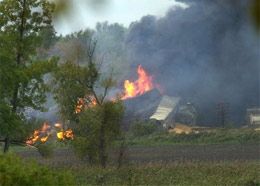By Michael Petroff
FDSOA western region director
 AP Photo/Jamie-Andrea Yanak Derailed railroad cars burn in Painesville, Ohio, last October. Several cars from the freight train hauling ethanol and other hazardous chemicals derailed, setting off a large fire. |
Rising crude oil prices and environmental and political issues are leading to the greater use of alternative fuels and renewable fuels. These fuels pose tactical and strategic challenges for firefighters and the safety officers responsible for the incident. They’re unique in many ways and differ from the challenges posed by hydrocarbon fires.
Hydrogen and ethanol are two of the alternative and renewable fuels being commonly used today. One of the unique hazards of these two products is that both can burn with an invisible or almost invisible flame. This clean burning makes the fuels a choice for environmental considerations, but presents danger for firefighters.
Ethanol is most predominantly mixed with gasoline at 10 percent of the volume of the latter. It is also being used at a mixture of 85 percent ethanol to 15 percent gasoline. Automobile racing fans will be familiar with ethanol (and methanol) as a racing fuel.
Indianapolis Motor Speedway changed fuels from gasoline to methanol in the 1960s. The hazards of the invisible fire were seen in the 1964 Indianapolis 500 when Parnelli Jones’ car caught fire during a pit stop. It took a seemingly long while for pit fire crews to realize that Parnelli Jones was on fire as he jumped from his car.
Major research
The Ethanol Emergency Response Coalition has done research on the use of firefighting foams and ethanol fires. The results are not surprising, but indicate a potential gap in firefighting capabilities for many departments.
They showed that alcohol-resistant foam must be used to extinguish and secure the spill area of an ethanol fire. The foam must be applied at the required density and mixed at the proper percentage.
Conventional AFFF may extinguish the fire, but provides no burn-back or re-ignition protection. See the coalition’s web site for test results and coalition information. Additional information on foams can be found from various foam manufacturers as well as from the Williams Hazard Control web site.
Hydrogen is another alternative fuel that is being increasingly used today. The United States Department of Energy has developed a training resource, “Introduction to Hydrogen Safety for First Responders.” This resource includes chemical characteristics of hydrogen, hazards and response guidelines. Hydrogen is shipped as either a gas or liquid and has different United Nations identification numbers for each. Gaseous hydrogen is placarded with the number 1049, while liquid is 1966. Liquid hydrogen also presents cryogenic hazards.
As gasoline prices increase, other hazards may develop such as additional fuel being carried in the trunks of cars (drivers taking advantage of lower prices), fuel hoarding and theft of fuels. All of these hazards were seen in the gasoline crisis of the 1970s. The new millennium and fuel costs may cause history to repeat itself.
Firefighters and safety officers must be aware of these changes that are occurring in our world. Training and education are the tools that must be employed to reduce the hazards presented by these alternative fuels.
 |
Lt. Bill Greenwood is a Pro-Board Certified NFPA 1041 Instructor-III, NFPA 1021 Fire Officer-II, NH Certified Firefighter-III, Rapid Intervention Team Instructor, NFPA 1003 & FAA Airport Rescue Firefighter, NREMT-Intermediate and EMT-I/C. He is a 16-year veteran of the fire service with experience in various volunteer, paid-call, and career fire departments throughout New Hampshire. He is currently working as a career lieutenant with the Keene, NH, Fire Department and owns advanced firefighter training and leadership company, FETC Services.










